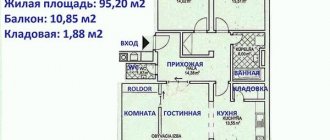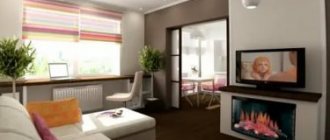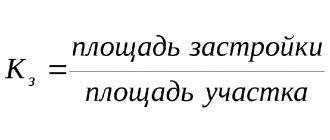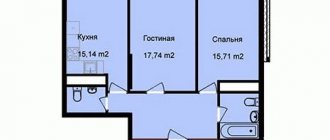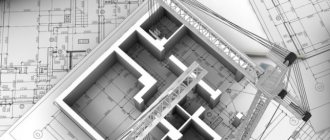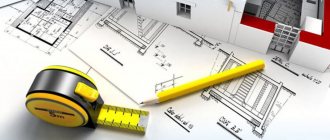What is included in the total living area of an apartment - controversial issues
- Total - the sum of all housing areas that must be accounted for in accordance with the Housing Code of the Russian Federation.
- Living room - the sum of the areas of living rooms that are allocated as such during the design of the building. The semantic purpose of this room is permanent residence of a person.
- Useful - in our country - is the sum of the areas of all premises, taking into account the balcony, mezzanine, except for stairwells, elevator shafts, ramps and the like; abroad - the sum of only the used areas.
The buyer signed an agreement with the developer on shared participation, with the expectation of buying an apartment of 77 sq. m. m. Including the area of the loggia. However, in the contract there were no references to the coefficients used in the calculations and a copy of the floor plan of the building.
Calculation of area in a new apartment
It is quite natural that the variety of similar terms leads to confusion when it comes to concluding real estate transactions. This question arises especially acutely when purchasing a new apartment. Here are some disagreements:
- According to the shared construction agreement, the developer must include in the deed a description of all the premises of the apartment included in the design documentation for the construction of the house.
- As you know, the construction of residential buildings in our country is carried out according to SNiP standards. They, in turn, refer to the housing code, in the paragraph determining the inclusion of premises in the total area.
From this we can conclude that the calculation is made taking into account reduction factors.
It is the manipulation of terms that makes it possible for unscrupulous developers to confuse potential clients. There are two marketing approaches to calculating the cost of one square meter of housing:
- The living area is taken as the basis. Naturally, the price per square meter in this case will be higher. But this approach is much more correct from a legal point of view, since the buyer will not have to pay for a cold non-residential balcony and loggia.
- But if the developer wants to attract potential buyers, he takes the total area of the apartment as a basis. With this calculation, one square meter of housing costs less. But under the guise of residential meters, you are given a balcony and a loggia, which, you see, do not at all fit into the category of residential premises.
That is why, when purchasing housing in a new building or at the construction stage, you need to be especially interested in such additional rooms as a balcony and loggia. Many people mistakenly believe that such designs are the same, but this is not the case, especially when the area of the apartment is considered:
- By definition, a loggia has additional side walls and a ceiling, which is not a load-bearing structure. In addition, the loggia, as a rule, has additional insulation and a continuous parapet.
- The balcony, in turn, is an external structure. That is, it always protrudes beyond the load-bearing walls. This design has a ceiling, which is the basis for the balcony above.
According to current legislation, any redevelopment of housing, including the conversion of a balcony into a loggia, must be reflected in the relevant documents and have permitting confirmation from the relevant authorities.
Advice! That is why you should not immediately choose the option that offers lower prices per square meter. You should carefully study the documentation of the residential building and clarify what area is taken to calculate the cost of a meter of housing. In addition, all changes and redevelopments must be reflected in the design documentation and DDU.
Total and living area of the apartment
In housing transactions, an important role is played by the exact determination of the area of the objects. It directly affects the market value of real estate. The total living area is determined for the apartment.
Clarification of the general quadrature is necessary for the following purposes:
- calculation of heating payments;
- statistical monitoring of construction volumes;
- preparation of technical documentation for the apartment;
- determination of the tax base (property tax);
- calculating the value of a property;
- taking into account the standard of living quarters when concluding a social tenancy agreement;
- calculating housing maintenance fees;
- calculation of social benefits associated with living in an apartment.
The footage of residential premises is determined for other purposes:
- registration of a mortgage agreement with a bank;
- transactions with real estate - donation, purchase and sale;
- assessing sanitary and living conditions, for example, when considering the living conditions of a minor child.
The concept of total area is somewhat broader than the concept of residential area. It includes not only bedrooms and living rooms, but also auxiliary rooms - a kitchen, a bathroom. With balconies and loggias, everything is not so obvious and unambiguous.
Living space
First you need to decide on the terminology. SNiP 2.08.01−89 “Residential buildings” clearly defines the concepts that explain such names as “loggia”, “balcony”, “veranda”. They have the following meaning:
- A glassed-in room built-in or attached to an apartment building (MKD) that does not have heating or electricity is called a veranda. Also, it should not have depth restrictions.
- An integrated building with limited depth, connected to the nearest living room by electrical wiring, is called a loggia.
- A balcony is similar to a loggia, that is, it also has limitations in terms of footage and is connected to the next room by electricity.
When signing an investment agreement for the purchase of an apartment with a developer, people often have the problem of correctly calculating square meters, which affects the final cost of housing. When preparing documents, you need to correctly calculate the area of the balcony in a residential building.
If we look at the issue from the point of view of the law, many developers who decide to include a balcony in the total area of housing do not have the right to do so. The quadrature is calculated using reduction factors.
Whether the footage of the loggia should be taken into account and why, there is no definite answer, since ideas about this differ in different documents. The confusion occurs due to the fact that during construction the rules described in SNiP 31.01-2003, as well as current building codes, must be observed . This document states that the quadrature is calculated in accordance with the requirements specified in the “Instructions on the accounting of residential real estate in the Russian Federation.”
total area
The loggia is included in the total area of the apartment, since according to the law, this term includes the total footage of absolutely all premises. This means that this should include auxiliary rooms to meet the needs of residents.
You can find and calculate this indicator yourself. All you need to do is measure all the lengths and enter them into a special Rosreestr calculator. This will allow you to find out what the cadastral value of the property is (approximate).
Some time ago, the total area of the apartment was considered without a balcony. That is, this room was not included in the number of additional rooms. This means that previously it was possible to calculate the cost of a house without taking it into account. Also, the premises were not mentioned when registering the certificate for the apartment.
Since then, amendments have been made to the Housing Code. And now the total area of the apartment includes a balcony. This must be kept in mind when buying, selling or re-registering property.
Because of this, when calculating the total area, the footage increases, which increases the final cost of the property. The law classifies offices, living rooms and bedrooms as living rooms. The following are considered additional:
- Loggias and balconies.
- Closets.
- Kitchens.
- Dining rooms.
Much depends on the coefficients used. The design space is calculated for a balcony with a multiplier of 0.3, and for a loggia - 0.5. These premises are included in the total area and are taken into account during construction. It is the entire quadrature that is recorded in the technical passport for the apartment.
The issue of heating is decided individually. If radiators are installed, and in the cold season you can spend time on the loggia, then this space is classified as heated. This, of course, affects the amount of utility bills. Each square meter of additional premises will be included in the receipt for housing and communal services.
Is the loggia included in the total area of the apartment - how to take it into account when buying a home?
It's quite easy to meet a cheater. The developer interprets the legislative framework according to his own understanding and often misleads his clients. If you resort to studying legislation, building rules, orders, the following information becomes clear:
- In the Housing Code of the Russian Federation, in Art. Figure 15 shows the principle for calculating the size of an apartment. Even auxiliary premises are supposed to be included in the footage, but do not take into account the balcony with a loggia.
- SNiP states that the entire area consists of zones with and without heating batteries. Moreover, a reduction factor must be applied to unheated ones.
- The instructions for accounting for housing stock speak of a single area as the sum of parameters for all premises without exception. And the cost of real estate is calculated using coefficients for a loggia - 0.5, a balcony - 0.3.
According to the above information, it turns out that when selling an apartment, the total area includes loggias with balconies. This is true, but the price is calculated with a reduction factor.
But the information in the residential complex does not comply with building regulations. The explanation is simple. Housing laws coordinate the relationship between operating companies and apartment owners, and joint ventures between construction organizations and buyers.
When selling housing, calculating its price, the company classifies the loggia as the total area. This is correct, because money was spent on the construction of this part of the apartment. However, the corresponding coefficient must be taken into account.
What is the difference between verandas, balconies and loggias?
To fully understand the difference in reduction factors, you must first understand the differences in each attached room. For example, it is typical for loggias that they are rooms of limited depth that are built into a residential building. This does not depend at all on the presence of a glazed part. The balcony is also a room in an apartment building of limited depth. Unlike loggias, it protrudes beyond the facade and in this way differs from it. But the loggias have side walls. They are designed in such a way as not to disturb the natural light of the adjacent room.
A coefficient equal to one is applied to the veranda. It differs in that it not only does not block the daylight flow into the next room, but even has its own separate lighting. In addition, the adjoining room gets its own independent window.
What is a balcony
In building codes and regulations 2.08.01-89, in the first attachment “Residential buildings” the definition of the concept and its analogues is indicated. Balcony, loggia, veranda, as well as their glazed versions - built-in or attached premises. The latter are not heated or illuminated by a circuit adjacent to the next room, and have no restrictions on dimensions, except for height. The verandas are adjacent to the building, the other two are built-in. A loggia differs from a balcony in the absence of a heating system or electric lighting. Each type has an enclosing and load-bearing common building structure in the project.
Balcony and total area of the apartment - legislative framework
To understand whether the loggia is included in the total area of the apartment, you need to study several regulations. This is the Housing Code of the Russian Federation, Code of Rules “Residential Multi-Apartment Buildings”, Order No. 37 of the Ministry of Land Construction of the Russian Federation, Federal Law of December 30, 2004 N 214-FZ.
SNiP standards for balconies
The real estate market is based on the standards specified in SNiP 31-01-2003 “Residential multi-apartment buildings”. To determine the area of the apartment, the application in form “B” makes a reference to the “Instructions on conducting accounting of the housing stock in the Russian Federation” (hereinafter referred to as the Instructions). Paragraph 3.34 of the Instructions divides the calculation into three categories: living area, apartment area and total area. The instructions give a comprehensive answer: the area of the balcony is still included in the total area of the apartment.
Regulatory acts
To determine the final price of living space, you need to know its full footage. Area is the main indicator when calculating the cost of a residential property. However, the question arises: is the area of the loggia included in the total area of the apartment.
The footage of the apartment is calculated as follows:
- The total area of the OKS (square meters of a capital construction facility, that is, an apartment) is the sum of square meters of all premises that are included in the living space.
- Living area is calculated by adding the square meters of all rooms that are intended only for living.
- Usable area - calculated according to square meters in all rooms, including the mezzanine and balcony. Premises from common property (stairs, ramps, elevators, etc.) are not included here.
Calculating the footage of the total area of housing may be necessary in the following cases:
- Used when calculating heating payments.
- To record and maintain statistics of construction projects.
- When preparing documents for property.
- Required when calculating property tax.
- Required to calculate payment for the use of common property (payment for common house needs - ODN).
- To calculate social benefits.
What is the living space indicator used for:
- When signing real estate transactions, including donations and other types of alienation.
- To assess sanitary standards, for example, to determine living conditions.
- To obtain various preferences, the size of which directly depends on the number of square meters per family.
- To determine the amount of fees for public areas.
- Other life situations.
In order to clarify the issue of the participation of a balcony (loggia) in the area of the apartment, you need to refer to the following standards:
- Article 15 of the Housing Code of the Russian Federation, which states that a balcony and loggia are not considered an integral part of the total area of the apartment. The norm has been in effect since 2015.
- The set of rules on residential multi-apartment buildings states that the total area is calculated by adding the square meters of all premises with and without heating. In this case, the size of cold rooms is calculated with a reducing factor.
- Clause 3.37 of the Order of the Ministry of Land Policy of the Russian Federation dated 08/04/1998, which determines the value of reducing coefficients.
- Letter from the Ministry of Regional Development of the Russian Federation dated October 09, 2009, the text of which establishes the method of calculating the total area together with the area of the balcony (loggias), but using reducing factors.
You can familiarize yourself with the Housing Code of the Russian Federation here.
The Code of Practice for residential multi-apartment buildings is available for reading and downloading here.
How to correctly take into account the reduction factor?
If a developer offers 100-meter apartments for sale at 60 thousand rubles per square meter and they have an area of 4 m2 for balconies and 6 m2 for loggias, then the total cost will be 6 million rubles. By applying a reducing factor, we get different numbers. Then all the main premises will cost 5.4 million, extensions will cost 72 and 180 thousand rubles, respectively. The total correct price for the final buyer will decrease by as much as 348 thousand and amount to 5.652 million rubles. As you can see, the amount saved by complying with the law is quite significant. In modern houses with an improved layout, extensions can reach 20 m2! And there are often several of them.
What is a reduction factor
Anything that extends beyond the common walls of the building is not considered an apartment.
Terraces, loggias and balconies are included in the “summer premises” section and are not suitable for living according to the Housing Code.
Coefficient
- this is a legal reduction in the total cost of the apartment. The ratio of balcony to living area is 0.3. To increase the square footage of a summer room, multiply its area by 0.3 and add it to the rest of the rooms. If it is a loggia, it refers to a built-in unheated room with a coefficient of 0.5. These figures will be useful for the papers of the Bureau of Technical Inventory.
Remember that the purchase and sale agreement must include a floor plan. Check out the footage of the summer unheated sections to check whether the coefficient has been applied to them.
|
For example, a developer sells apartments of 100 m2 for 60,000 rubles per square meter. The balconies of these apartments are 4 m2, and the loggias are 6 m2. The total cost of such housing is 6,000,000 rubles. If you apply a reduction factor, you will get different numbers. The total area of the premises will be 96 and 94 m2, and the summer extensions will have a reduction factor of 1.2 and 3 m2. After recalculation, the main premises will cost 5.76 and 5.64 million, and the extensions will cost 72 and 180 thousand, respectively. The correct price of the apartments will be 5,832,000 and 5,800,000 rubles. If you apply the correct calculations, you can save up to 200,000 on your purchase.
What is owned after calculating the coefficient
Although the coefficient of loggias and balconies is confirmed by non-regulatory acts, it indicates inconsistencies in the laws. You think that you have paid for the entire square footage of your apartment, however, by law, balconies are included in the common property of the house. Therefore, your personal possession will only be the footage between the walls, and the common property of the apartment building is:
- floor;
- ceiling;
- walls;
- base plate;
- façade wall;
- communications;
- parapet.
The right of private property extends only to what is within these limits. In such a case, it is unlawful to demand payment for extra unheated meters. Naturally, there will be no complaints regarding the use of this space. But remember that you should not damage or interfere with public property, so as not to receive a fine.
Reduction factors
Whether the loggia is included in the total area depends on the purpose for which the calculation is carried out:
- If you need to calculate the square footage of an apartment that will soon be put into operation during development, the area of the balcony and loggia must be taken into account, but reducing factors must be applied to them.
- If a simple calculation of the total footage is required (to calculate utilities, taxes, benefits, and so on), then the areas of additional extensions in the form of balconies, loggias, terraces will not be included in the calculations.
The footage of the balcony is taken into account during construction, because the developer needs to calculate the cost of the apartment taking into account the costs incurred for the construction of these auxiliary premises. The developer bears the costs of constructing balconies and loggias, despite the fact that their production is much cheaper than the construction of a residential (heated) premises, which means the price of the balcony should be included in the price of the apartment.
The reduction factors set for individual premises are different, mostly in the range from 0.3 to 1:
- Loggias – 0.5.
- Balconies, terraces – 0.3.
- Veranda – 1.0.
Let's give an example of how the use of coefficients affects the price of residential premises.
The developer is selling an object of 70 sq. m. meters, of which 8 sq. meters is a balcony. The price per square meter is set at 40,000 rubles.
The approximate cost of the apartment is 2,800,000 rubles (70 sq.m * 40,000 rubles). Since the apartment has a balcony, when calculating, a reducing factor of 0.3 should be used, that is, the size of the balcony will be reduced: 8 sq.m * 0.3 = 2.4 sq.m.
As a result, the price of the apartment: (70 sq.m. – 2.4 sq.m.) * 40,000 = 2,696,000 rubles.
That is, the final cost of the purchased property will be significantly less.
If, when calculating the final cost of housing, the developer did not apply reducing factors, you can safely apply for the protection of your rights to the supervisory authorities, and then to the court. Judicial practice on this matter contains court decisions, according to which the buyer was not only returned the amount he had paid in excess, but also compensated for moral damages.
Algorithm for performing calculations
The shapes of balconies are very diverse. They are rectangular, beveled, round, elongated.
It is not difficult to measure a rectangular or square structure, but calculating the area of a balcony of complex shapes is much more difficult. The last task can be made easier by dividing the required space into simple geometric shapes. For example, a bay window can be divided into a triangle and a rectangle.
- The first thing to do after this is to carefully measure the sides of the resulting figures using a tape measure or rangefinder.
- Draw a sketch of the room or its drawing on paper and mark the dimensions of all the figures on it.
- It is recommended to perform all calculations related to calculating area using a calculator.
- Calculate the area of the figures in the drawing.
Agreement with the developer
It makes no sense for developers to meet buyers halfway and strive to help them save money and reduce material costs. Therefore, every construction company tries to insure itself in advance. This comes down to the fact that there will probably be a clause in the contract that states that there may be a slight difference between the projected and actual area of the apartment. If this fact is discovered, the buyer will not make a claim. Often, buyers agree and sign documents in advance. To learn how to correctly draw up an agreement with a developer and make changes, watch this video:
Terminology
It is known that our compatriots are not very versed in legal subtleties. Therefore, when the need arises to understand the terminology, many literally “grab their heads” - there is so much to take into account. Let's try to figure it out.
total area
According to current legislation, the total area includes all premises of the apartment:
- auxiliary;
- built-in;
- balconies;
- loggias;
- terraces;
- verandas.
When calculating the area of some premises, it is necessary to apply the appropriate coefficients:
- for terraces and balconies it is 0.3;
- for loggias – 0.5;
- for unheated storerooms and verandas – 1.0.
Living space
The Housing Code is quite clear about what is included in the living space - these are all the interior spaces of the apartment. An exception to this list are verandas and terraces; balconies and loggias are also not included.
The redevelopment of the apartment, when the loggia or balcony was combined with the apartment, makes them heated. In this case, they are included in the living area of the apartment.
Advice! Having made a major renovation of the apartment and adding a balcony or loggia to the room, be prepared for the fact that the rent and heating bills will increase. This will happen legally, since the living space of your apartment has increased.
Payment of housing and communal services for a balcony
But when paying for housing and communal services, you need to be careful: you may find that you are also paying for a balcony, but your neighbors or friends are not. Why did this happen? Utility organizations, focusing on the Housing Code of the Russian Federation, count the rent in the receipt in accordance with Article 15. If the area is indicated in the cadastral passport along with the balcony, nothing can be done. If you are purchasing a home, you should carefully study the transfer and acceptance certificate for the apartment: if you fill it out carefully, you will not face any extra charges in the receipt for balcony meters.
To avoid paying utility bills for a balcony when purchasing an apartment, contact our real estate agency. We will help you fill out the documents correctly, save your time and significant amounts on utility bills while living in your new home.
Apartment in three dimensions
When purchasing or shared construction of housing, disputes often arise between the developer and the shareholder on how to calculate the area of the apartment.
This happens because ordinary citizens do not see the differences between different concepts of area, and unscrupulous developers take advantage of this. The issue price is the final cost of the apartment.
Our reader Evgenia from the city of Volzhsk encountered a similar situation. Is the developer right in trying to count the loggia into the total area of the apartment and, accordingly, demand payment for this area, asks Evgeniya. And will the developer be right if he says that the area of the loggia is taken into account since it is glazed?
So, when concluding a shared participation agreement, the developer provides a description of the shared participation object (apartment), based on the data from the design documentation for the house. The design and construction of multi-apartment residential buildings under construction are carried out on the basis of SNiP 31-01-2003 (residential multi-apartment buildings). However, multi-apartment residential buildings that began construction according to design documentation developed and approved before January 1, 2004, can be built and put into operation without adjusting the design documentation in accordance with the requirements of these norms and rules.
The said SNiP establishes the following: “The area and other technical indicators calculated for the purposes of statistical accounting and technical inventory are determined according to the rules established in the “Instructions on the accounting of housing stock in the Russian Federation.” This document was approved by order of the Ministry of Land Construction of the Russian Federation dated August 4, 1998 N 37, but the last changes to it were made on May 19, 2008.
You can find a lot of interesting things in his text. For example, the fact that an apartment has three different areas: the living area of the apartment, the area of the apartment, and the total area of the apartment.
The living area of an apartment is defined as the sum of the areas of living rooms.
The area of the apartment is determined as the sum of the areas of living rooms and utility rooms, excluding loggias, balconies, verandas, terraces and cold storage rooms, vestibules. Utility rooms include the area of kitchens, corridors, bathrooms, toilets, built-in closets, storage rooms, as well as the area occupied by the internal staircase.
The total area of the apartment is determined as the sum of the areas of its premises, built-in wardrobes, as well as the areas of loggias, balconies, verandas, terraces and cold storage rooms, calculated with the following reduction factors: for loggias - 0.5, for balconies and terraces - 0.3, for verandas and cold storage rooms - 1.0.
Indicators of the total area of an apartment are used for the purposes of state statistical monitoring of the volume of housing construction in the Russian Federation.
Indicators of apartment area are used for the purposes of official statistical accounting of the housing stock in the Russian Federation, payment of housing and utilities, determination of the social standard of housing and other purposes.
The Housing Code, which, by the way, is “more important” than the above regulatory documents, also defines the total area of a residential premises: “The total area of a residential premises consists of the sum of the area of all parts of such a premises, including the area of auxiliary premises intended for the satisfaction of citizens with household and other needs related to their living in residential premises, with the exception of balconies, loggias, verandas and terraces.” The definition of “total area” given by the Housing Code of the Russian Federation, in its essence, fully corresponds to the definition of “apartment area” contained in the “Instructions...”
By the way
in the “Instructions...” there is an interesting explanation: “The concept of “total area”, previously used in official statistical accounting of the housing stock, is equivalent to the concept of “apartment area.”
What should the reader do?
If you want, challenge the terms of the concluded agreement in court, but success will largely depend on the wording of the agreement and the experience of a lawyer or attorney, who in this situation must be contacted. question-answer
I read your consumer educational program in Rossiyskaya Gazeta, in which you say that an apartment that does not have electrical wiring, plumbing, etc. cannot be considered an apartment. Please tell me the name of the law.
Chairman of the meeting of deputies of the municipality "Pinega region" Soplyakova E.S.
Articles 15 and 16 of the Housing Code of the Russian Federation establish the following. Residential premises are recognized as isolated premises, which are real estate and are suitable for permanent residence of citizens (meets established sanitary and technical rules and regulations, and other legal requirements).
Residential premises include:
- residential building, part of a residential building;
- apartment, part of an apartment;
- room.
An apartment, in particular, is recognized as a structurally separate room in an apartment building, providing direct access to the common areas in such a house and consisting of one or more rooms, as well as auxiliary premises intended to satisfy citizens’ household and other needs related to their residence in such a separate room.
Under a shared construction agreement, we purchased a 2-room apartment with a living area of 36.28 sq. m. m, total 70.66 sq. m. The apartment acceptance certificate states that the apartment being transferred to me consists of one room with an area of 20.9 square meters. m and kitchen rooms with an area of 29.2 sq. m, which is classified as non-residential area. This happened because according to the plan, there is an opening of more than two meters between the kitchen and one of the rooms, and PIB accepted these two rooms as one. The construction company first agreed to complete the redevelopment on its own and obtain a new technical passport. But then she refused. What should I do to get the apartment that I purchased under the contract?
Yulia Movchan
The obligations of each party under the contract must be performed in strict accordance with its terms. Unilateral changes to the terms of the contract are prohibited by law. If the terms of the contract oblige the developer to provide a two-room apartment, it is precisely such an apartment that should be transferred to you. If the developer refuses, it is necessary to go to court. To draw up a statement of claim, I strongly advise you to contact competent lawyers who have similar experience.
Homeowner's Dictionary
Veranda
- a glazed, unheated room attached to or built into a building, open to the outside space, fenced on three sides by walls (on two sides in case of a corner location) a room with a depth limited by the requirements of natural light in the room to the outer wall of which it adjoins. May be glazed.
Lobby
- a room in front of the entrance to the internal parts of a residential building, intended for receiving and distributing flows of visitors.
Yard structures
- buildings for auxiliary, household purposes: fences, gates, cesspools, wells, yard coverings, etc.
Homeownership
- a residential building and buildings and structures serving it, located on a separate plot of land.
Living room
- part of an apartment, dormitory, separated from other premises (rooms) by partitions, intended for living and recreation. In addition to living rooms, a residential apartment includes corridors, halls, kitchens, bathrooms, bathrooms, storage rooms, internal vestibules, and hallways.
Corridor
- part of the room, which is a means of communication with other rooms in the room, regardless of width and illumination, is taken into account as non-residential premises.
Loggia
- a room covered and fenced in plan on three sides, open to the outside space, serving for recreation in the summer and sun protection.
Hallway (front)
- part of the room that has direct access to the stairs, common corridor, etc.
Terrace
- a fenced open area attached to a building or placed on the roof of a lower floor. It may have a roof and exit from adjacent rooms of the house.
(Definitions are given in SNiP 01/31/2003)
Feedback
The consumer educational program is led by the head of the legal department of the Moscow branch of the Union of Consumers of Russia, Irina Sokolova.
You can ask your questions every Friday from 12.00 to 14.00 by phone, send them by mail to the editorial office or by email:
[email protected]
Is it possible to enlarge the apartment with a balcony?
It's possible, but you need to do it right. Your plans can be greatly spoiled by the harsh reality - namely, the irrational use of additional meters or incorrect approval of work in the BTI. For those who want to increase the size of their home with a balcony, here are a few recommendations on how to do this legally.
- Define functionality. For example, additional space on the kitchen side can be used as a dining room, storage room or TV area. In the bedroom you can set up an office or dressing room.
- Remember the rules. It is completely prohibited to remove batteries. If you want to install heating, install a heated floor, but only an electric one.
- Coordinate all work. If you are going to demolish a dividing wall, you must coordinate the project in advance with the BTI and make a thermal engineering calculation.
Extending the balcony
The home area can be increased by expanding the space on the balcony, since in old houses this is a rather small room. This situation especially applies to “Stalin” and “Khrushchev” buildings. They contain loggias with parameters of 1.7 by 1 m. In this case, it is very difficult to use the space as a living space.
Such balconies are only suitable for storing some old things or preservation. To get out of the situation, you will need to increase the balcony. There are two main ways:
- Removal of glazing.
- Slab expansion.
You can increase the size of the balcony if you move the glazing along the parapet. In this case, the actual space becomes larger, but what appears in the documents remains the same. This method does not require permission.
A more complex way is to increase the perimeter of the load-bearing slab (by a maximum of 30%). Its disadvantage is that permission to change the design is quite difficult to obtain.
Removal of glazing
Before starting work on removing the glazing, it is necessary to check the condition of the parapet. It is often made from a monolithic reinforced concrete slab. In this case, you will need to purchase or make your own triangles from steel corners. They are placed at a distance of 30 cm from each other. The extreme points are connected by a channel, the end of which should rest against the wall.
There are also balconies where the parapet is made in the form of a metal fence. In this case, the procedure is as follows:
- The main part of the parapet is dismantled. It is necessary to leave only those elements that touch the balcony slab.
- Square pipes are installed vertically on the slab at a distance of 30-40 cm. The height should be approximately 1 meter.
- A metal plate is welded underneath around the perimeter, in which holes are made for anchors.
- The top trim is performed using a channel. To the ends of this element you need to weld paws intended for fastening to the wall.
After removing the parapet, similar work is done with the ceiling. Metal corners need to be attached to the wall (the distance should be kept within 40-45 cm) . The ends are tied at the same level as the balcony slab . After this, galvanized flashings are installed and all seams are sealed. If required, you can insulate the roof using mineral wool. At the last stage, the balcony is glazed.
Balcony or loggia?
As a rule, in high-rise buildings, each apartment has a balcony included in the total area (with a few exceptions, for example, such a room is often not provided on the first floors). Moreover, in one- and two-room apartments there is only one balcony; in three- and four-room apartments there is a balcony and a loggia.
Many people confuse these two terms, although there are clear differences between these spaces:
- A balcony is always an external structure. It “looks out” beyond the load-bearing walls of the building, and its ceiling is the floor of the balcony located on the floor above.
- A loggia is a space equipped with a ceiling and a side wall, which are not load-bearing structures. The loggia is usually initially insulated and equipped with a continuous parapet.
The legal requirements are very clear. If the owner carries out redevelopment, including combining a balcony with a room, turning it into a loggia, this requires changes to the housing documentation. Initially, all the geometric dimensions, plan and area of the apartment with all its premises are in the documents issued by the BTI.
The area of the balcony in the house needs to be known for many tasks. This is important for any manipulations with real estate, as well as for carrying out any construction and repair work: painting, insulation. You will need this parameter and a sketch of the balcony to purchase lockers and other furniture.
